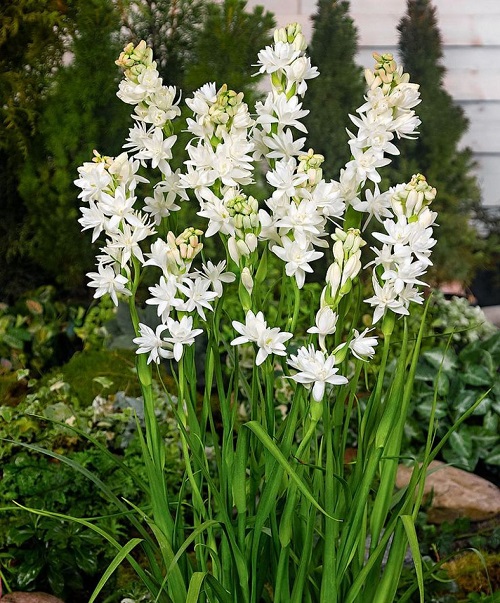
Tuberoses (Polianthes tuberosa) are beautiful, highly fragrant flowers known for their long-lasting blooms. Here's a guide on how to grow tuberoses:
Selecting Bulbs:
- Purchase tuberose bulbs from a reputable source or garden center. Look for large, firm bulbs that are free from signs of damage or decay.
Planting Time:
- Plant tuberose bulbs in the spring after the danger of frost has passed, typically when soil temperatures reach around 60°F (15°C).
- If you live in a region with a warm climate, you can also plant tuberoses in the fall for winter bloom.
Choosing a Location:
- Select a sunny location for planting tuberoses. They prefer full sun, receiving at least 6 to 8 hours of direct sunlight each day.
- Ensure the soil is well-draining, as tuberoses do not tolerate waterlogged conditions.
Soil Preparation:
- Prepare the soil by removing any weeds, rocks, or debris from the planting area.
- Loosen the soil to a depth of 8 to 10 inches (20 to 25 cm) using a garden fork or tiller.
- Incorporate organic matter, such as compost or well-rotted manure, into the soil to improve its structure and fertility.
Planting Depth and Spacing:
- Dig holes that are about 4 to 6 inches (10 to 15 cm) deep and space them 6 to 8 inches (15 to 20 cm) apart.
- Place the tuberose bulbs in the holes with the pointed end facing up and the root end facing down.
- Backfill the holes with soil, gently firming it around the bulbs.
Watering:
- After planting, water the bulbs thoroughly to settle the soil and initiate root growth.
- Provide regular watering throughout the growing season, keeping the soil evenly moist but not waterlogged.
- During dry spells, water deeply to ensure the roots have adequate moisture.
Support:
- As the tuberose plants grow, they may benefit from staking or support to prevent bending or falling over. Place stakes or install a support structure near the plants and tie the stems gently for support.
Fertilization:
- Apply a balanced fertilizer, such as a slow-release granular fertilizer, when planting tuberose bulbs.
- For established plants, apply a balanced fertilizer every 4 to 6 weeks during the growing season, following the manufacturer's instructions.
Mulching:
- Apply a layer of organic mulch, such as straw or wood chips, around the tuberose plants. Mulching helps conserve moisture, suppress weed growth, and regulate soil temperature.
Maintenance:
- Remove any weeds or competing plants around the tuberoses to reduce competition for nutrients and water.
- Deadhead faded flowers regularly to promote continuous blooming and prevent the plant from directing energy towards seed production.
- In areas with cold winters, tuberose bulbs can be lifted and stored in a cool, dry place for winter.
With proper care and attention, tuberoses will reward you with their exquisite fragrance and elegant blooms. Enjoy the beauty and scent of these lovely flowers in your garden or containers.

No comments:
Post a Comment